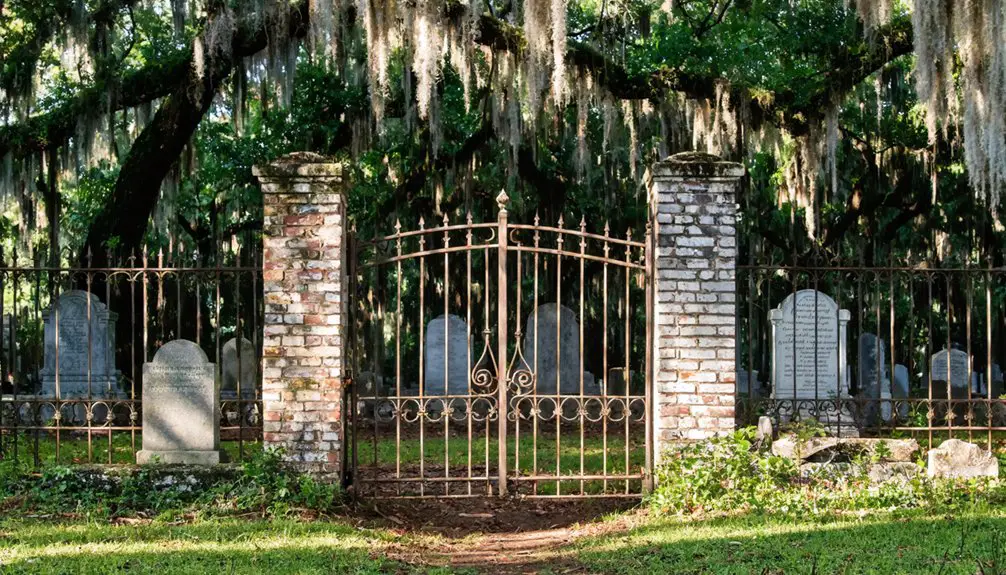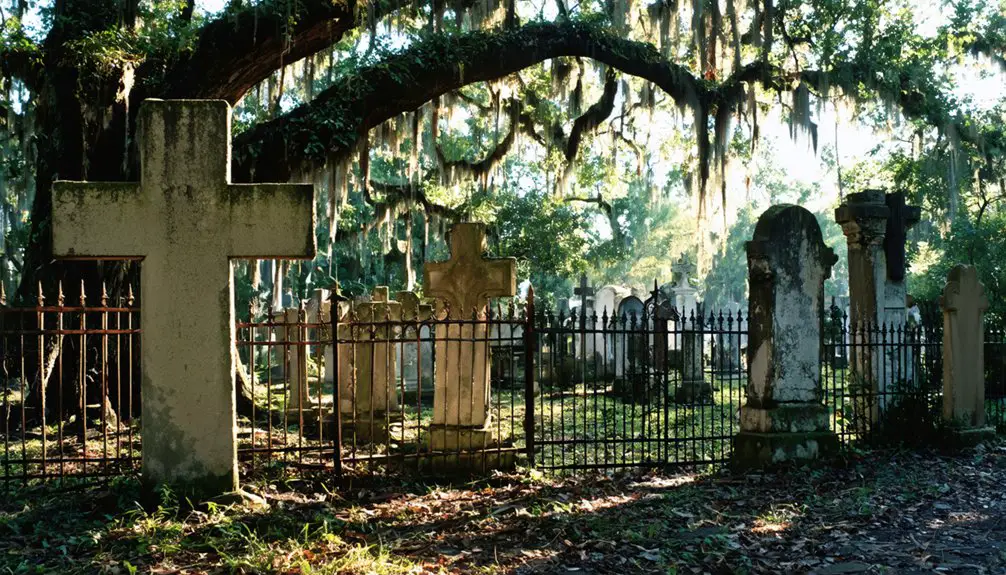You’ll find Newnansville’s remains 1.5 miles northeast of present-day Alachua, Florida, where this pioneering town once served as Alachua County’s first county seat. From its 1826 start as Dell’s Post Office, it grew into a fortified haven during the Second Seminole War, housing hundreds of soldiers and settlers. Though the town died after being bypassed by railways in the 1850s, its historic cemetery still holds the keys to Florida’s frontier past.
Key Takeaways
- Newnansville was a former Florida Territory settlement and Alachua County seat that became completely deserted by 1900.
- The town’s decline began when railroads bypassed it in the 1850s and 1880s, causing businesses and residents to relocate.
- Today, only the historic Newnansville Cemetery remains, listed on the National Register of Historic Places since 1974.
- During the Second Seminole War, Fort Gilliland protected 259 soldiers and hundreds of civilians in Newnansville.
- The ghost town site is located 1.5 miles northeast of present-day Alachua, Florida, accessible via State Road 235.
From Dell’s Post Office to Frontier Hub
When James and Simeon Dell established their post office in 1826, they couldn’t have known they were laying the foundation for one of Florida Territory‘s most important frontier settlements. Their modest operation, with James earning less than $10 as postmaster in his first year, sparked remarkable community development along Bellamy Avenue.
You’ll find the settlement’s early identity was tied directly to the Dell brothers, known first as “Dell’s Post Office” and “Dell’s Court House” before the Florida Legislature renamed it Newnansville in 1824.
The post office became a nucleus for growth, attracting stores and a Methodist church. As one of only nine post offices in the territory, it served as a crucial communications hub. The Timucuan tribes had originally inhabited this land before European settlers arrived.
From humble postal beginnings sprang a vibrant frontier community, as commerce and faith gathered around this vital communications center.
The strategic location near fertile lands and key transportation routes transformed this frontier outpost into a thriving regional center. The construction of a 25-foot wide road allowed wagon traffic to flow through the settlement, further establishing its importance.
Life During the Second Seminole War
Newnansville’s bustling growth came to an abrupt halt in 1835 as the Second Seminole War erupted across Florida Territory.
As violence spread, you’d have witnessed the town transform into a fortified safe haven. Fort Gilliland’s military fortifications housed 259 soldiers, while hundreds of refugees sought protection behind the strengthened courthouse walls. The Battle of San Felasco demonstrated the intense conflict between U.S. forces and Seminole warriors. General Winfield Scott oversaw a massive 5,000-man campaign aimed at subduing the Seminole resistance.
The town’s civilian resilience shone through as residents adapted to life under siege:
- You’d find up to 300 Seminole warriors conducting raids near Colonel Sanchez’s plantation
- Local militia and soldiers pursued raiders while protecting crucial supply routes
- Families balanced daily survival with maintaining civic order, despite constant threats
The Rise and Fall of a County Seat
In 1824, a small settlement known as Dell’s Post Office transformed into the bustling county seat of Alachua County, taking the name Newnansville after military commander Daniel Newnan.
You’d have found a thriving hub of community governance, with a courthouse anchoring the town’s early infrastructure alongside a Methodist church, school, and hotel.
The town became a notable communications center when one of nine post offices in the Florida territory was established there in 1826.
By 1853, the town’s prominence diminished when the county seat was moved to Gainesville, leaving only the historic cemetery as evidence of its existence.
Railroad’s Impact on Town Survival
The arrival of two major railroads in the region sealed Newnansville’s fate as a ghost town. When both the Florida Railroad and the Savannah, Florida and Western Railroad bypassed the town, the railroad significance became clear – you couldn’t survive without rail access in 19th-century Florida.
The urban migration that followed was swift and decisive, with most residents and businesses relocating just a mile south to establish Alachua. The former county seat status was completely lost when the government functions moved to Gainesville in 1854. The town had previously served as a bustling commercial center for the Middle Florida frontier.
- Commercial buildings were physically moved to the new railroad town
- F.E. Williams helped develop Alachua around “Newnansville Station”
- Essential services like the post office, hotels, and mills followed the tracks
What you’re seeing is a classic example of how railroad access determined a town’s survival. While Alachua flourished with its new depot, Newnansville emptied out, becoming deserted by 1900.
Legacy in Stone: The Historic Cemetery
You’ll notice distinct differences in the tombstone shapes at Newnansville Cemetery, where curved-top stones mark Union soldiers’ graves and pointed-top markers indicate Confederate veterans’ final resting places.
Like many tranquil resting places, the cemetery provides a peaceful setting for visitors to reflect on the area’s history and honor those who came before.
The burial grounds preserve the memory of both Northern and Southern Civil War soldiers, often interred alongside their family members in pioneer-era plots.
These military grave markers, combined with unique local burial customs like family groupings, tell the story of Florida’s complex role in America’s bloodiest conflict.
Local families like the Hancocks continue the tradition of placing flags on veterans’ graves during Veterans Day visits.
Unique Burial Traditions
Buried beneath ancient oaks in Newnansville Cemetery, generations of Florida’s early settlers left behind a remarkable legacy carved in stone.
You’ll discover burial customs that tell a complex story of a divided society, with separate sections for African American and white residents reflecting the era’s segregation. The cemetery’s rich symbolism appears most vividly in the African American section, where bright colors, toys, beads, and elephant motifs adorn the headstones.
- Family plots cluster together, showcasing the deep kinship bonds that defined the community.
- Confederate and Union soldiers rest side by side, revealing how war touched local families.
- Traditional African American grave decorations survived even hurricane damage, preserving cultural heritage.
The cemetery’s stones don’t just mark graves – they chronicle the untold stories of early Florida’s frontier spirit.
War Heroes Rest Here
Among the weathered headstones of Newnansville Cemetery, three generations of war heroes tell a compelling story of American military legacy.
You’ll find both Union and Confederate soldiers laid to rest here, their allegiances marked by distinct tombstone shapes – curved for Union, pointed for Confederate.
The cemetery’s military legacy extends beyond the Civil War, with World War II veterans like Henry J. Hammon Jr. resting in the African American section.
You’ll discover family groupings that showcase generations of service, from early settlers to modern-day heroes.
Despite Newnansville’s disappearance as a town, veteran recognition remains strong at this historic site.
As you walk among the graves, you’re witnessing one of Florida’s most significant military burial grounds, where the sacrifices of countless soldiers are eternally preserved in stone.
Economic Forces Behind the Ghost Town
The economic downfall of Newnansville stands as a classic example of how transportation infrastructure can make or break a frontier town.
You’ll find that two crucial railroad bypasses in the 1850s and 1880s led to the town’s economic isolation, forcing businesses and residents to relocate to better-connected areas like Gainesville and Alachua.
The town’s agricultural vulnerability, heavily dependent on cotton production, left it ill-equipped to weather such dramatic shifts in transportation networks.
- Loss of county seat status to Gainesville in 1854 stripped away political influence
- Lack of rail access cut off essential trade routes and commercial opportunities
- Migration of businesses to railroad-connected towns created a self-reinforcing cycle of decline
Where to Find Newnansville Today

Modern-day visitors seeking Newnansville’s remains will find the ghost town approximately 1.5 miles northeast of present-day Alachua, Florida, just off State Road 235 from US 441.
While no original buildings stand today, you’ll discover the historic Newnansville Cemetery, the site’s most prominent feature, marked by tombstones of both Union and Confederate soldiers distinguished by their curved and pointed tops respectively.
You can explore the cemetery grounds and view historical markers during daylight hours. The site, listed on the National Register of Historic Places since 1974, offers a glimpse into Florida’s pioneer past.
For a deeper investigation into regional history, you’ll find related sites nearby, including the Grady House Bed and Breakfast and Wacahoota Cemetery within a 20-mile radius.
Frequently Asked Questions
What Happened to the Original Buildings and Structures of Newnansville?
You’ll find most buildings were relocated near the railroad or demolished, with only cemetery remnants surviving. Despite building preservation efforts and historical archaeology studies, structures faded into ghost town status by 1900.
Were There Any Famous Residents or Notable Visitors to Newnansville?
You’ll find Daniel Newnan, the town’s namesake, and the Dell brothers among the most notable residents. While there weren’t nationally famous visitors, military leaders and government officials frequented this territorial hub.
How Many People Lived in Newnansville During Its Peak Years?
Before its dramatic population decline and lost historical significance, you’d have found nearly 3,000 residents there during peak years, making it Florida’s fourth-largest community behind St. Augustine, Pensacola, and Tallahassee.
What Native American Artifacts Have Been Found at the Newnansville Site?
You’ll find Native artifacts including Newnan projectile points, pottery sherds, stone tools, and dugout canoes. Their historical significance spans over 6,000 years of indigenous presence in this area.
Did Any Significant Events or Battles Occur in Newnansville Besides Seminole Conflicts?
Like a quiet sentinel in Florida’s wilderness, you won’t find major battles beyond Seminole skirmishes here. The town’s pioneer life centered on Civil War-era commerce and daily frontier activities.
References
- https://chazzcreations.com/alachua_county_historic_towns/newnansville
- https://travelmadepersonal.com/newnansville-ghost-town-florida/
- https://www.cityofalachua.com/discover/about-alachua/history/a-prelude-to-a-town
- https://www.wuft.org/florida-good/2017-11-20/newnansville-story
- https://en.wikipedia.org/wiki/Newnansville
- http://www.geocities.ws/krdvry/hikeplans/alachua/planalachua.html
- https://www.ghosttowns.com/states/fl/newnansville.html
- https://en.wikipedia.org/wiki/Battle_of_San_Felasco_Hammock
- https://en.wikipedia.org/wiki/Second_Seminole_War
- https://dos.fl.gov/florida-facts/florida-history/seminole-history/the-seminole-wars/



